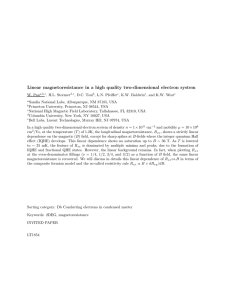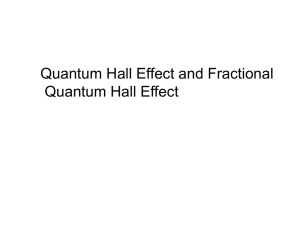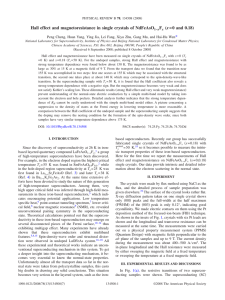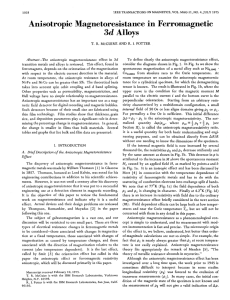CONDUCTION MECHANISM IN GRANULAR Ru02
advertisement
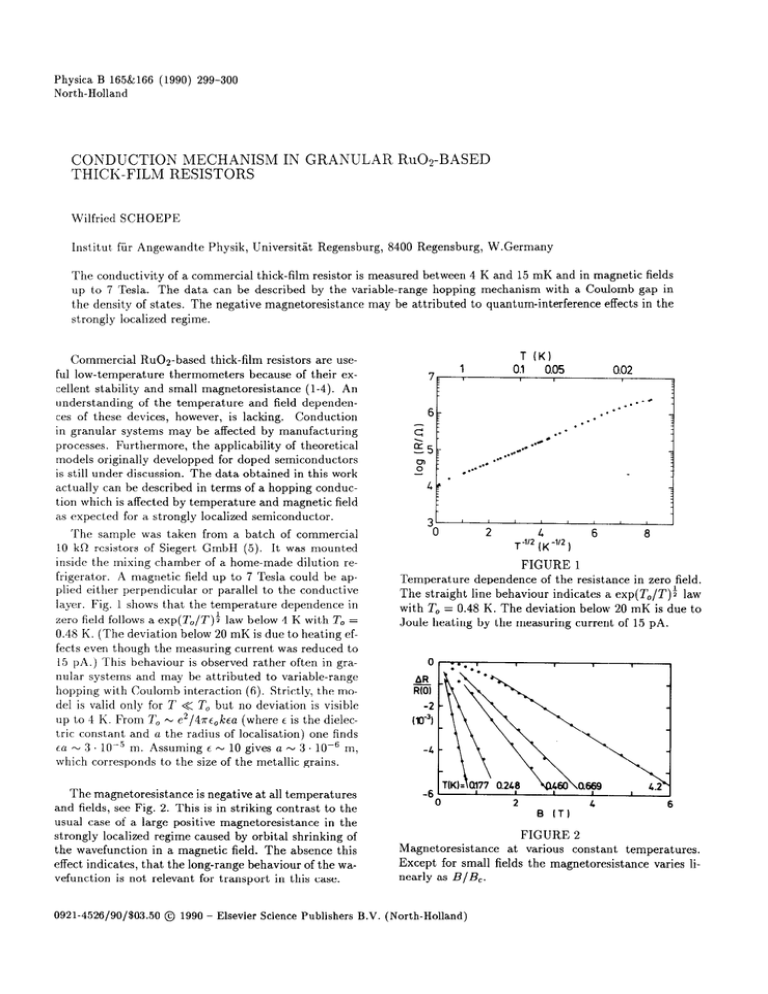
Physica B 165&166 North-Holland (1990) 299-300 CONDUCTION MECHANISM IN GRANULAR Ru02-BASED THICK-FILM RESISTORS Wilfried SCHOEPE Institut fiir Angewandte The conductivity up to 7 Tesla. the density strongly Physik, Universitit of a commercial thick-film The of states. localized Commercial processes. models devices, systems however, is lacking. tion which is affected by temperature from 10 kR resistors of Siegert GmbH layer. chamber A magnetic Fig. 0.48 K. (The deviation (l-4). An conducfield semiconductor. a batch (5). or parallel 3o-d It was mounted dilution re- to the conductive dependence current is observed in del is valid only for ?’ < (6). Strictly, Z’, but no deviation up to 4 K. From 7’, N e2 /4?rc,kca (where t is the dielectric constant ta - 3 10-s and a the radius of localisation) m. Assuming which corresponds is negative usual case of a large positive localized the wavefunction effect indicates, vefunction in a magnetic by orbital field. that the long-range is not relevant 0921-4526/90/$03.50 @ contrast magnetoresistance regime caused heating 0 R(OI a. by the measuring 1 of the wa- 1990 -El sevier Science Publishers current of 15 pA. 0.669 L.2 I -4 TIK).Cl177a2L8 0 50 2 L 0 of in this case. law below 20 mK is due to -2 - -6 this in zero field. a exp(T,,/T)i HO-3I in the shrinking -. . to the The absence behaviour for transport Joule grains. at all temperatures and fields, see Fig. 2. This is in striking strongly m, -. J&is indicates with To = 0.48 K. The deviation one finds c N 10 gives a N 3. lo@ to the size of the metallic The magnetoresistance line behaviour A!3_. is visible 8 The straight to the mo- 6 FIGURE 1 dependence of the resistance often in gra- to variable-range L T-l/2 (K-l/2) Temperature ef- was reduced rather and may be attributed interaction 2 of commercial law below 4 K with Z’,, = the measuring with Coulomb T (Kl in this work below 20 mK is due to heating 15 pA.) This behaviour hopping effects in the of theoretical 1 shows that the temperature systems fields gap in Conduction of a home-made zero field follows a exp(Z’,/T): nular ex- field up to 7 Tesla could be ap- perpendicular fects even though with a Coulomb to quantum-interference are use- and magnetic localized was taken plied either mechanism for doped semiconductors sample frigerator. may be attributed of their in terms of a hopping for a strongly inside the mixing 4 K and 15 mK and in magnetic hopping by manufacturing The data obtained can be described The between W.Germany and field dependen- the applicability developped is still under discussion. as expected resistors because may be affected Furthermore, originally actually magnetoresistance thick-film thermometers of the temperature ces of these is measured by the variable-range and small magnetoresistance understanding in granular The negative Ru02-based stability resistor can be described 8400 Regensburg, regime. ful low-temperature cellent data Regensburg, Magnetoresistance Except nearly at 6 ITI FIGURE various 2 constant temperatures. for small fields the magnetoresistance as B/B,. B.V. (North-Holland) varies li- 300 PI. Schoepe A negative magnetoresistance of the hopping mechanism has recently been calculated on the basis of quantum interference effects of the tunneling electron (7-9). The magnetic field dependence is predicted to be linear except for very small fields where it should increase quadratically. This is in agreement with the data of Fig. 2. The temperature dependence of the linear part should scale as r-g, where r cc (T,/T)) is the temperature dependent hopping length (9). Therefore, the inverse of the slopes of the straight lines should vary as Tf . The experimental results, see Fig. 3, are approximately described by a T2 law for T 5 To and tend to saturate above 1 K. This is consistent with the above mechanism. A more detailed analysis requires a calculation of the prefactor which is not yet available. 10 0.l 1 5 T (Kl FIGURE 3 The temperature dependence of B, (i.e. of the inverse of the slopes in Fig. 2). ACKNOWLEDGEMENTS It is a pleasure to thank W. Pfab of Siegert GmbH for supplying the sample. I have had very helpful discussions on the theory with W. Schirmacher and B. Shklovskii. Similar experiments were performed simultaneously and independently by K. Neumaier and I am grateful to him for cummunicating his results prior to publication. REFERENCES (1) H. Doi, Y. Narahara, Y. Oda and H. Nagano, Proceedings LT 17, eds. U. Eckern et al. (North Holland, Amsterdam, 1984) p. 405. (2) W.A. Bosch, F. Mathu, H.C. Meijer and R.W. Willekers, Cryogenics 26 (1986) 3. (3) Q. Li, C.H. Watson, R.G. Goodrich, D.G. Haase and H. Lukefahr, Cryogenics 26 (1986) 467. (4) M.W. Meisel, G.R. Stewart and E.D. Adams, Cryogenics 29 (1989) 1168. (5) Siegert GmbH, D-8501 Cadolzburg, W.Germany. (6) B.I. Shklovskii and A.L. Efros, Electronic properties of doped semiconductors (Springer-Verlag, Berlin, 1984). (7) V.L. Nguen, B.Z. Spivak and B.I. Shklovskii, Zh. Eksp. Teor. Fiz 89 (1985) 1770 (English translation Sov. Phys. JETP 62 (1985) 1021). (8) U. Sivan, 0. Entin-Wohlman and Y. Imry, Phys. Rev. Letters 60 (1988) 1566. (9) W. Schirmacher, Phys. Rev. B., to be published.
